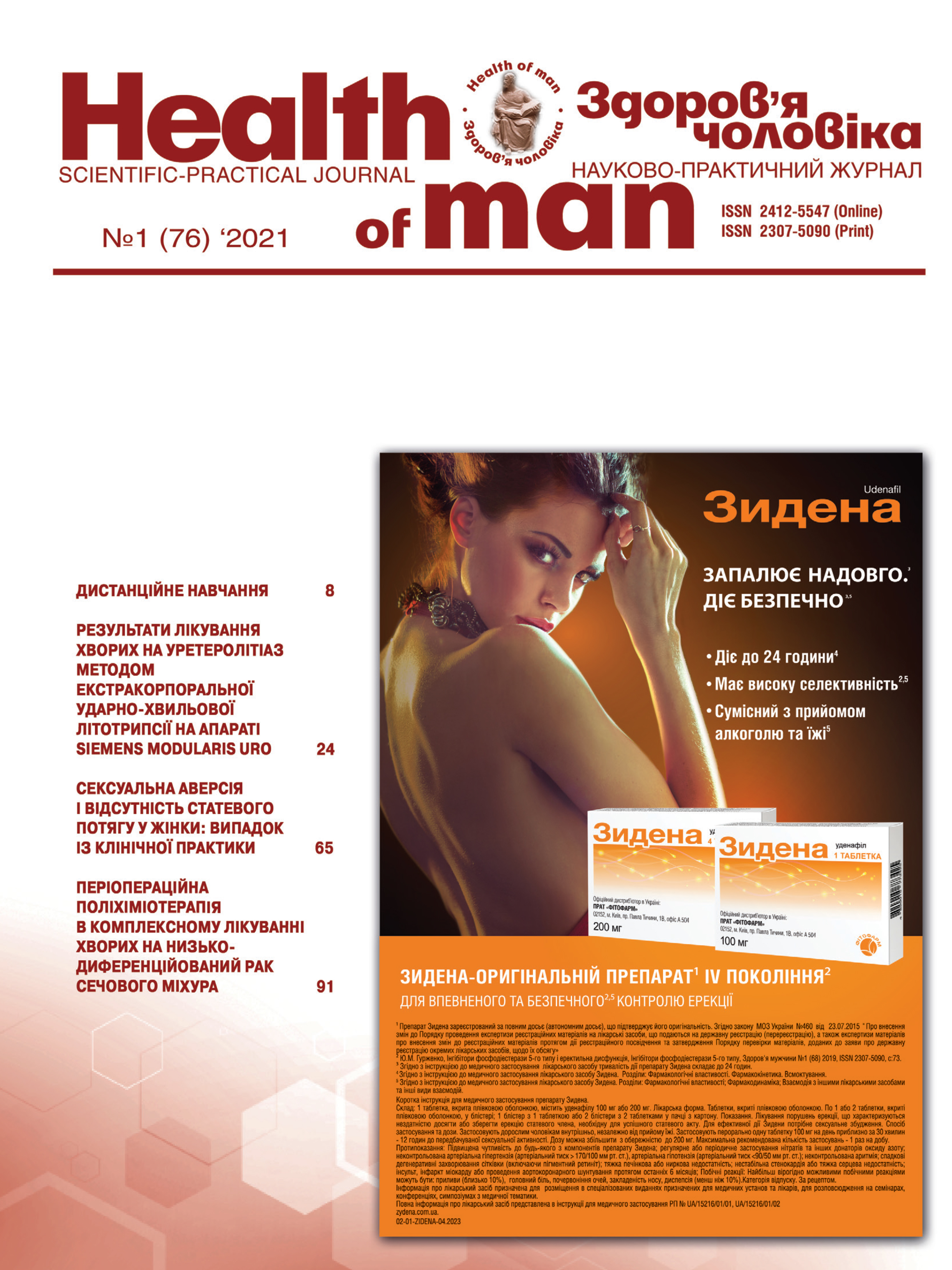Rehabilitation of Patients with Benign Prostate Hyperplasia with Urinary Bladder Decompensation
##plugins.themes.bootstrap3.article.main##
Abstract
The article is devoted to the problem of bladder decompensation and related complications in patients with BPH.
The objective: to study the effectiveness of certain methods of restoring the functional capacity of the detrusor in patients with BPH with bladder decompensation.
Materials and methods. The results of treatment of 149 patients with BPH with bladder decompensation aged 47 to 83 years (68,3±7,9) were analyzed, the proportion of which was 39,11 % of the total number of operated on BPH. Two groups of patients were formed by random sampling – every 2–3 patients. Group I included 30 people who underwent cystostomy. Group II included 30 people who, in addition to cystostomy, underwent metabolic-corrective and anticholinesterase therapy. The complex of drugs included B vitamins: octothiamine – 25 mg, riboflavin – 2,5 mg, pyridoxine hydrochloride – 40 mg, cyanocobalamin – 0,25 mg 3 times a day for 4 weeks; Anticholinesterase drug – ipidacrine 20 mg 3 times a day for 4 weeks.
Results. According to the results of pathomorphological examination in both groups of observation there was desquamation of the urothelium, growth of connective tissue, bundles of nerve fibers with the phenomena of dystrophy. Degenerative changes in smooth muscle cells were accompanied by a decrease in the proportion of muscle tissue and a decrease in the diameter of leiomyocytes. However, in patients who underwent preoperative metabolism-corrective therapy, the diameter of the lumen of the arterioles was 20.21 % larger (p<0,05), the wall thickness of the arterioles – 31,73 % smaller (p<0,05), the Kernogan index is 28,22 % lower (p<0,05), the diameter of the capillaries is 3,52 % higher (p>0,05). The diameter of leiomyocytes was 45,26 % larger (p<0,05), the proportion of connective tissue in the bladder wall – 29,14 % lower (p<0,05). Compared with patients who underwent only cystostomy, after metabolic-corrective and anticholinesterase therapy in the short and long postoperative period were better indicators of functional capacity of the detrusor. 6 months after the second stage of the operation according to uroflowmetry Qmax was higher by 32,92 % (p<0,05), Qave – higher by 62,27 % (p<0,05), IPSS – lower by 33,18 % (p<0,05) and the QoL index is better by 29,54 % (p<0,05).
Conclusions. Bladder decompensation due to untimely removal of the obstructive component is the main cause of unsatisfactory treatment results in patients with BPH. Anticholinergic exercise may be an additional factor in bladder decompensation in patients with BPH. Metabolism-correcting and anticholinesterase therapy permit to restore detrusor function by eliminating microcirculatory disorders and energy deficiency, stimulating neurotransmitter, neuromuscular conduction and smooth muscle contraction. In patients with megacystis, additional surgical correction by duplication allows the bladder to be emptied.
##plugins.themes.bootstrap3.article.details##

This work is licensed under a Creative Commons Attribution 4.0 International License.
Authors retain the copyright and grant the journal the first publication of original scientific articles under the Creative Commons Attribution 4.0 International License, which allows others to distribute work with acknowledgment of authorship and first publication in this journal.
References
Gravas S, Cornu JN, Gacci M, Gratzke C, Herrmann TRW, Mamoulakis C, et. al. EAU Guidelines on Non-Neurogenic Male LUTS Including Benign Prostatic Obstruction. EAU Guidelines. Edn. presented at the EAU Annual Congress Amsterdam 2020. ISBN 978-94-92671-07-3. Publisher: EAU Guidelines Office. Place published: EAU Guidelines Office, Arnhem, The Netherlands. Available from: https://uroweb.org/guideline/treatment-of-non-neurogenic-male-luts/
Fusco F, Creta M, Imperatore V, Longo N, Imbimbo C, Lepor H, Mirone V. Benign Prostatic Obstruction Relief in Patients with Lower Urinary Tract Symptoms Suggestive of Benign Prostatic Enlargement Undergoing Endoscopic Surgical Procedures or Therapy with Alpha-Blockers: A Review of Urodynamic Studies. Adv Ther. 2017 Apr;34(4):773–83.
Shormanov YS, Vorchalov MM, Ukharskyi AV. Patohenetycheskyi podkhod klechenyiu DHPZ oslozhnennoi khronycheskoi zaderzhkoi mochy. Eksperymentalnaia i klynycheskaia urolohyia. 2014;3:58–64. [in Russian]
Speakman M, Kirby R, Doyle S, Ioannou C. Burden of male lower urinary tract symptoms (LUTS) suggestive of benign prostatic hyperplasia (BPH) – focus on the UK. BJU international. 2015;115(4):508–19.
Nepomnyashchikh LM, Lushnikova EL, Neimark AI. Remodeling of the muscle layer (detrusor muscle) of hyperactive bladder disease in patients with benign prostatic hyperplasia. Bulletin of experimental biology and medicine. 2012;153(5):778–83.
Bosch R, Abrams P, Averbeck MA, Finazzi Agró E, Gammie A, Marcelissen T and Solomon E: Do functional changes occur in the bladder due to bladder outlet obstruction? – ICI-RS 2018. Neurourol Urodyn. 2019.38(5). 56–S65.
Sarychev LP, Starchenko II, Savchenko RB, Sarychev YV, Pustovoit HL. Kliniko- morfolohichne obhruntuvannia likuvalnoi taktyky u khvorykh na dobroiakisnu hiperplaziiu peredmikhurovoi zalozy. Urologiya. 2020.94(3).237–8. [in Ukrainian]
Howdeshell KL, Hotchkiss AK, Gray LE. Cumulative effects of antiandrogenic chemical mixtures and their relevance to human health risk assessment. International journal of hygiene and environmental health. 2017.220(2). 179–88.
Duran CE, Azermai M, Vander Stichele RH. Systematic review of anticholinergic risk scales in older adults. European journal of clinical pharmacology. 2013.69(7).1485–96.
Verhamme KM, Sturkenboom MC, Stricker BH, Bosch R () Drug-induced urinary retention: incidence, management and prevention. Drug Saf : Int J Med Toxicol Drug Experience. 2008.31(5).373–88.
Jacquia F, Kisby C, Wu JM, Geller EJ. Impact of anticholinergic load on bladder function. International Urogynecology Journal. 2015.26(4).545–9.
Altun I, Kurutas EB. Vitamin B complex and vitamin B12 levels after peripheral nerve injury. Neural regeneration research. 2016.11.842–5.
Sugaya K, Kadekawa K, Onaga T, Ashitomi K, Mukouyama H, Nakasone K, et al. Effect of distigmine at 5 mg daily in patients with detrusor underactivity. Nihon Hinyokika Gakkai Zasshi. 2014.105.10–6.
Maksimova MI, Okhtova F, Sineva NA, Vodopianov NP. Neuromidin in the treatment of stage I hypertensive dyscirculatory encephalopathy. Ter Arkh. 2013.85.87–90.
Blaivas J, Chancellor M. Atlas of urodynamics. Baltimore: William & Wilkins, 2007; Chapt 2, pp. 11–21.
Sarychev LP, Savchenko RB, inventors; Ukrainian Medical Stomatological Academy. Method for surgical treatment of patients with megacyst due to prolonged infravesical obstruction. Ukraine patent 141479. 2020 Apr 10.





